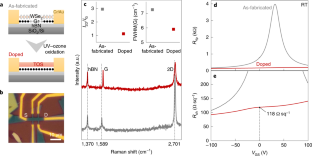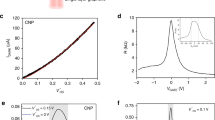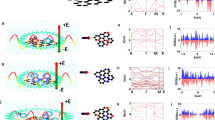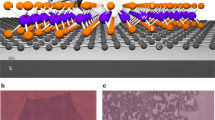Abstract
Doped graphene could be of use in next-generation electronic and photonic devices. However, chemical doping cannot be precisely controlled in the material and leads to external disorder that diminishes carrier mobility and conductivity. Here we show that graphene can be efficiently doped using a monolayer of tungsten oxyselenide (TOS) that is created by oxidizing a monolayer of tungsten diselenide. When the TOS monolayer is in direct contact with graphene, a room-temperature mobility of 2,000 cm2 V−1 s−1 at a hole density of 3 × 1013 cm−2 is achieved. Hole density and mobility can also be controlled by inserting tungsten diselenide interlayers between TOS and graphene, where increasing the layers reduces the disorder. With four layers, a mobility value of around 24,000 cm2 V−1 s−1 is observed, approaching the limit set by acoustic phonon scattering, resulting in a sheet resistance below 50 Ω sq−1. To illustrate the potential of our approach, we show that TOS-doped graphene can be used as a transparent conductor in a near-infrared (1,550 nm) silicon nitride photonic waveguide and ring resonator.
This is a preview of subscription content, access via your institution
Access options
Access Nature and 54 other Nature Portfolio journals
Get Nature+, our best-value online-access subscription
$29.99 / 30 days
cancel any time
Subscribe to this journal
Receive 12 digital issues and online access to articles
$119.00 per year
only $9.92 per issue
Buy this article
- Purchase on Springer Link
- Instant access to full article PDF
Prices may be subject to local taxes which are calculated during checkout





Similar content being viewed by others
Data availability
The data that support the findings within this paper are available from the corresponding authors upon reasonable request.
Change history
24 November 2021
A Correction to this paper has been published: https://doi.org/10.1038/s41928-021-00696-5
References
Pierret, R. F. Semiconductor Device Fundamentals (Addison-Wesley, 1996).
Seabaugh, A. C. & Zhang, Q. Low-voltage tunnel transistors for beyond CMOS logic. Proc. IEEE 98, 2095–2110 (2010).
Shen, L. et al. Ohmic contacts with ultra-low optical loss on heavily doped n-type InGaAs and InGaAsP for InP-based photonic membranes. IEEE Photon. J. 8, 4500210 (2016).
Ma, L.-P. et al. Pushing the conductance and transparency limit of monolayer graphene electrodes for flexible organic light-emitting diodes. Proc. Natl Acad. Sci. USA 117, 25991–25998 (2020).
Low, T. & Avouris, P. Graphene plasmonics for terahertz to mid-infrared applications. ACS Nano 8, 1086–1101 (2014).
Jena, D. & Konar, A. Enhancement of carrier mobility in semiconductor nanostructures by dielectric engineering. Phys. Rev. Lett. 98, 136805 (2007).
Schedin, F. et al. Detection of individual gas molecules adsorbed on graphene. Nat. Mater. 6, 652–655 (2007).
D’Arsié, L. et al. Stable, efficient p-type doping of graphene by nitric acid. RSC Adv. 6, 113185–113192 (2016).
Yager, T. et al. High mobility epitaxial graphene devices via aqueous-ozone processing. Appl. Phys. Lett. 106, 063503 (2015).
Mehta, A. N. et al. Understanding noninvasive charge transfer doping of graphene: a comparative study. J. Mater. Sci.: Mater. Electron. 29, 5239–5252 (2018).
Lee, H., Paeng, K. & Kim, I. S. A review of doping modulation in graphene. Synthetic Met. 244, 36–47 (2018).
Chen, K. et al. Air stable n-doping of WSe2 by silicon nitride thin films with tunable fixed charge density. APL Mater. 2, 092504 (2014).
McClellan, C. J., Yalon, E., Smithe, K. K. H., Suryavanshi, S. V. & Pop, E. High current density in monolayer MoS2 doped by AlOx. ACS Nano 15, 1587–1596 (2021).
Nipane, A. et al. Damage-free atomic layer etch of WSe2: a platform for fabricating clean two-dimensional devices. ACS Appl. Mater. Interfaces 13, 1930–1942 (2021).
Pang, C.-S. et al. Atomically controlled tunable doping in high-performance WSe2 devices. Adv. Electron. Mater. 6, 1901304 (2020).
Dingle, R., Störmer, H. L., Gossard, A. C. & Wiegmann, W. Electron mobilities in modulation-doped semiconductor heterojunction superlattices. Appl. Phys. Lett. 33, 665–667 (1978).
Son, S. et al. Strongly adhesive dry transfer technique for van der Waals heterostructure. 2D Mater. 7, 041005 (2020).
Wang, L. et al. One-dimensional electrical contact to a two-dimensional material. Science 342, 614–617 (2013).
Yamamoto, M. et al. Self-limiting layer-by-layer oxidation of atomically thin WSe2. Nano Lett. 15, 2067–2073 (2015).
Wang, H., Wu, Y., Cong, C., Shang, J. & Yu, T. Hysteresis of electronic transport in graphene transistors. ACS Nano 4, 7221–7228 (2010).
Das, A. et al. Monitoring dopants by Raman scattering in an electrochemically top-gated graphene transistor. Nat. Nanotechnol. 3, 210–215 (2008).
Finney, N. R. et al. Tunable crystal symmetry in graphene–boron nitride heterostructures with coexisting moiré superlattices. Nat. Nanotechnol. 14, 1029–1034 (2019).
Sen, H. S., Sahin, H., Peeters, F. M. & Durgun, E. Monolayers of MoS2 as an oxidation protective nanocoating material. J. Appl. Phys. 116, 083508 (2014).
Yamamoto, M., Nakaharai, S., Ueno, K. & Tsukagoshi, K. Self-limiting oxides on WSe2 as controlled surface acceptors and low-resistance hole contacts. Nano Lett. 16, 2720–2727 (2016).
Wang, M. et al. Breaking the doping limit in silicon by deep impurities. Phys. Rev. Appl. 11, 054039 (2019).
Amet, F. et al. Composite fermions and broken symmetries in graphene. Nat. Commun. 6, 5838 (2015).
Dankerl, M. et al. Graphene solution-gated field-effect transistor array for sensing applications. Adv. Funct. Mater. 20, 3117–3124 (2010).
Zhao, J. et al. Application of sodium-ion-based solid electrolyte in electrostatic tuning of carrier density in graphene. Sci. Rep. 7, 3168 (2017).
Hess, L. H. et al. High-transconductance graphene solution-gated field effect transistors. Appl. Phys. Lett. 99, 033503 (2011).
Brown, M. A., Crosser, M. S., Leyden, M. R., Qi, Y. & Minot, E. D. Measurement of high carrier mobility in graphene in an aqueous electrolyte environment. Appl. Phys. Lett. 109, 093104 (2016).
Adam, S., Hwang, E. H., Galitski, V. M. & Sarma, S. D. A self-consistent theory for graphene transport. Proc. Natl Acad. Sci. USA 104, 18392–18397 (2007).
Browning, A. et al. Evaluation of disorder introduced by electrolyte gating through transport measurements in graphene. Appl. Phys. Express 9, 065102 (2016).
Hwang, E. H., Adam, S. & Sarma, S. D. Carrier transport in two-dimensional graphene layers. Phys. Rev. Lett. 98, 186806 (2007).
Xu, Y. et al. Creation of moiré bands in a monolayer semiconductor by spatially periodic dielectric screening. Nat. Mater. 20, 645–649 (2021).
Ruta, F. L., Sternbach, A. J., Dieng, A. B., McLeod, A. S. & Basov, D. N. Quantitative nanoinfrared spectroscopy of anisotropic van der Waals materials. Nano Lett. 20, 7933–7940 (2020).
Sze, S. M. & Ng, K. K. Physics of Semiconductor Devices (John Wiley & Sons, 2006).
Mews, M., Korte, L. & Rech, B. Oxygen vacancies in tungsten oxide and their influence on tungsten oxide/silicon heterojunction solar cells. Sol. Energy Mater. Sol. Cells 158, 77–83 (2016).
Lee, J. E., Ahn, G., Shim, J., Lee, Y. S. & Ryu, S. Optical separation of mechanical strain from charge doping in graphene. Nat. Commun. 3, 1024 (2012).
Nouchi, R. & Ikeda, K. I. Adsorbates as a charge-carrier reservoir for electrostatic carrier doping to graphene. Appl. Phys. Express 13, 015005 (2020).
Wu, G. et al. Programmable transition metal dichalcogenide homojunctions controlled by nonvolatile ferroelectric domains. Nat. Electron. 3, 43–50 (2020).
Borah, A., Sebastian, P. J., Nipane, A. & Teherani, J. T. An intuitive equivalent circuit model for multilayer van der Waals heterostructures. IEEE Tran. Electron Devices 65, 4209–4215 (2018).
Edelberg, D. et al. Approaching the intrinsic limit in transition metal diselenides via point defect control. Nano Lett. 19, 4371–4379 (2019).
Micallef, F. G. et al. Transparent conductors for mid-infrared liquid crystal spatial light modulators. Thin Solid Films 660, 411–420 (2018).
Tohsophon, T., Dabirian, A., De Wolf, S., Morales-Masis, M. & Ballif, C. Environmental stability of high-mobility indium-oxide based transparent electrodes. APL Mater. 3, 116105 (2015).
Morales-Masis, M. et al. Highly conductive and broadband transparent Zr-doped In2O3 as front electrode for solar cells. IEEE J. Photovolt. 8, 1202–1207 (2018).
Silva, É. Pd, Chaves, M., Durrant, S. F., Lisboa-Filho, P. N. & Bortoleto, J. R. R. Morphological and electrical evolution of ZnO: Al thin films deposited by RF magnetron sputtering onto glass substrates. Mater. Res. 17, 1384–1390 (2014).
Dhakal, T. et al. Transmittance from visible to mid infra-red in AZO films grown by atomic layer deposition system. Sol. Energy 86, 1306–1312 (2012).
Datta, I., Phare, C. T., Dutt, A., Mohanty, A. & Lipson, M. Integrated graphene electro-optic phase modulator. In Conference on Lasers Electro-Optics, STu3N.5 (OSA, Washington DC, 2017).
Yariv, A. Universal relations for coupling of optical power between microresonators and dielectric waveguides. Electron. Lett. 36, 321–322 (2000).
Amin, R. et al. Sub-wavelength GHz-fast broadband ITO Mach–Zehnder modulator on silicon photonics. Optica 7, 333–335 (2020).
Acknowledgements
We acknowledge fruitful discussions with S. Chae, X. Xu, K. Yao, J. Schuck and E. Hwang, as well as experimental support from L. D’Cruz. This work was primarily supported by the NSF MRSEC Program at Columbia in the Center for Precision-Assembled Quantum Materials (DMR-2011736 and DMR-1420634), in partnership with the National Research Foundation of Korea through the Global Research Laboratory (GRL) program (2016K1A1A2912707) and Research Fellow program (2018R1A6A3A11045864). Device characterization was supported by the National Science Foundation through the CAREER Award (ECCS-1752401). This work was performed in part at the Advanced Science Research Center NanoFabrication Facility at the Graduate Center of the City University of New York and in part at the Columbia Nano Initiative (CNI) Shared Lab Facilities at Columbia University. Synthesis of hBN (K.W. and T.T.) was supported by the MEXT Element Strategy Initiative to Form Core Research Center (grant number JPMXP0112101001) and the CREST(JPMJCR15F3), JST.
Author information
Authors and Affiliations
Contributions
M.S.C., A.N. and Y.J. designed and conducted the initial experiments under the supervision of J.H. and J.T.T. M.S.C. and A.N. stacked, fabricated and conducted the electrical, optical and material characterizations of the samples with B.S.Y.K.’s contribution. B.S.Y.K. established a model for a work-function-mismatch-based doping mechanism. M.E.Z. and X.Z. contributed to the transmittance measurement of CVD samples. I.D. and M. Lipson contributed to the optical loss measurements of TOS-doped graphene integrated into the SiN waveguide. A.B. contributed to the doping study of DNTT. B.K. and D.R. provided flux-grown WSe2 crystals. A.J. and A.N.P. provided the SWCNT grown on SiO2/Si. Z.A.L. and I.K. provided the grown DNTT on TOS. M. Lee contributed to the sample preparation. A.Z. contributed to the transmission electron microscopy, SAED and energy-dispersive X-ray spectroscopy measurements. M.N.N. contributed to the XPS measurements of CVD samples. T.T. and K.W. provided the hBN crystals. W.J.Y. contributed to discussions of the results. M.S.C., A.N. and B.S.Y.K. wrote the manuscript under the supervision of J.H. and J.T.T.
Corresponding authors
Ethics declarations
Competing interests
M.S.C., A.N., A.B., Y.J., J.H. and J.T.T. have filed for a US non-provisional patent application no. 17/236,404 regarding the technology reported in this article. The remaining authors declare no competing interests.
Additional information
Peer review information Nature Electronics thanks Jin Sik Choi and the other, anonymous, reviewer(s) for their contribution to the peer review of this work.
Publisher’s note Springer Nature remains neutral with regard to jurisdictional claims in published maps and institutional affiliations.
Supplementary information
Supplementary Information
Supplementary Figs. 1–16 and Tables 1 and 2.
Rights and permissions
About this article
Cite this article
Choi, M.S., Nipane, A., Kim, B.S.Y. et al. High carrier mobility in graphene doped using a monolayer of tungsten oxyselenide. Nat Electron 4, 731–739 (2021). https://doi.org/10.1038/s41928-021-00657-y
Received:
Accepted:
Published:
Issue Date:
DOI: https://doi.org/10.1038/s41928-021-00657-y
This article is cited by
-
Ultrafast charge transfer in mixed-dimensional WO3-x nanowire/WSe2 heterostructures for attomolar-level molecular sensing
Nature Communications (2023)
-
Exploring the electronic and thermal properties of S-graphene: robustness effects, magnetic fields, and doping
Applied Physics A (2023)
-
Ambipolar charge-transfer graphene plasmonic cavities
Nature Materials (2023)
-
Surface plasmons induce topological transition in graphene/α-MoO3 heterostructures
Nature Communications (2022)
-
Synthesis, properties, and applications of MBenes (two-dimensional metal borides) as emerging 2D materials: a review
Journal of Materials Science (2022)



